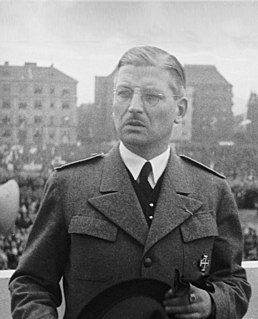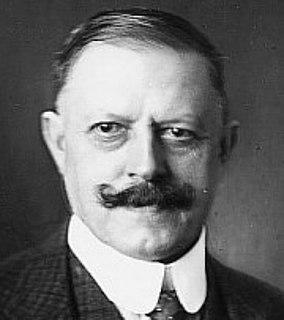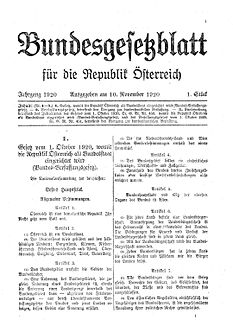Sepp Straffner (31 January 1875 Bad Goisern - 29 October 1952) was an Austrian federal railway official and politician in the Greater German People's Party. He was a pupil at Hallstatt near Salzkammergut, then a student in the Forestry Service at Goisern. He attended high school in Linz. Between 1899 and 1907 he was an official with the Tyrol and Salzburg service of the State Railways at Innsbruck. He went on to study law at the universities of Vienna and Innsbruck (PhD 1913).
Straffner was active in Georg von Schönerer's German National Movement (Deutschnationale Bewegung). He was a member of the council of Saalfelden, the Tyrolean Landtag and from 1918-1919 member of the Tyrolean government. In 1919 he was successful in the Constitutional Assembly elections, becoming a member of the Republic of German-Austria legislature, and from 1920 to 1923 and 1927 to 1934 a deputy in the National Council. In 1930-31 and 1932–33, he served as third president of the National Council.
He was one of the three national presidents who on 4 March 1933 resigned his office during a debate on a railway strike, precipitating a constitutional crisis, the dissolution of parliament and the seizure of power by the Chancellor, Engelbert Dollfuss as dictator. On 15 March 1933 Straffner tried to withdraw his resignation and reconvene the parliamentary session but Dollfuss had ordered the police to prevent this "undeclared meeting" ( „nicht angemeldete Versammlung“) or to disperse it if it occurred, even though many members of the Greater German and Social Democrat parties were already present in the chamber. Handed a copy of Dollfuss' order, Straffner filed a criminal complaint against Dollfuss under § 76 Criminal Code (public violence).
From 1934-1935 he was manager of the daily newspaper 'Alpenland'.

Engelbert Dollfuss was an Austrian clerical fascist politician who served as Chancellor of Austria between 1932 and 1934. Having served as Minister for Forests and Agriculture, he ascended to Federal Chancellor in 1932 in the midst of a crisis for the conservative government. In early 1933, he dissolved parliament and assumed dictatorial powers. Suppressing the Socialist movement in February 1934 during the Austrian Civil War and later banning the Austrian Nazi Party, he cemented the rule of "Austrofascism" through the authoritarian First of May Constitution. Dollfuss was assassinated as part of a failed coup attempt by Nazi agents in 1934. His successor Kurt Schuschnigg maintained the regime until Adolf Hitler's annexation of Austria in 1938.

The president of Austria is the head of state of the Republic of Austria. Though theoretically entrusted with great power by the Constitution, in practice the president is largely a ceremonial and symbolic figurehead.

The Greens – The Green Alternative is a green political party in Austria.

Kurt Alois Josef Johann von Schuschnigg was an Austrian Fatherland Front politician who was the Chancellor of the Federal State of Austria from the 1934 assassination of his predecessor Engelbert Dollfuss until the 1938 Anschluss with Nazi Germany. Although Schuschnigg accepted that Austria was a "German state" and that Austrians were Germans, he was strongly opposed to Adolf Hitler's goal to absorb Austria into the Third Reich and wished for it to remain independent.
The Heimwehr or Heimatschutz was a nationalist, initially paramilitary group operating in Austria during the 1920s and 1930s that was similar in methods, organization, and ideology to the Freikorps in Germany. It was opposed to parliamentary democracy, socialism and Marxism. Some of its regional groups also opposed Nazism while others favored it. In spite of its anti-democratic stance, the Heimwehr developed a political wing called the Heimatblock that was close to the conservative Christian Social Party and took part in both the cabinet of Chancellor Carl Vaugoin in 1930 and in Engelbert Dollfuss' right-wing government from 1932 to 1934. In 1936 the Heimwehr was absorbed into what was at the time the only legally permitted political party in Austria, the Fatherland Front, and then later into the Frontmiliz, an amalgamation of militia units that in 1937 became part of Austria's armed forces.

Ignaz Seipel was an Austrian prelate, Catholic theologian and politician of the Christian Social Party. He was its chairman from 1921 to 1930 and served as Austria's federal chancellor twice, from 1922 to 1924 and 1926 to 1929. Seipel's terms in office saw the reorganization of the state's finances and passage of the 1929 amendment to the federal constitution that strengthened the role of the Austrian President. As chancellor he opposed the Social Democratic Party of Austria and Austromarxism and supported paramilitary militias such as the Heimwehr, an organization similar to the German Freikorps.

Otto Bauer was one of the founders and leading thinkers of the left-socialist Austromarxists who sought a middle ground between social democracy and revolutionary socialism. He was a member of the Austrian Parliament from 1907 to 1934, deputy party leader of the Social Democratic Workers' Party (SDAP) from 1918 to 1934, and Foreign Minister of the Republic of German-Austria in 1918 and 1919. In the latter position he worked unsuccessfully to bring about the unification of Austria and the Weimar Republic. His opposition to the SDAP joining coalition governments after it lost its leading position in Parliament in 1920 and his practice of advising the party to wait for the proper historical circumstances before taking action were criticized by some for facilitating Austria's move from democracy to fascism in the 1930s. When the SDAP was outlawed by Austrofascist Chancellor Kurt Schuschnigg in 1934, Bauer went into exile where he continued to work for Austrian socialism until his death.
The Christian Social Party was a major conservative political party in the Cisleithanian crown lands of Austria-Hungary and under the First Austrian Republic, from 1891 to 1934. The party was affiliated with Austrian nationalism that sought to keep Catholic Austria out of the State of Germany founded in 1871, which it viewed as Protestant and Prussian-dominated; it identified Austrians on the basis of their predominantly Catholic religious identity as opposed to the predominantly Protestant religious identity of the Prussians.

Wilhelm Miklas was an Austrian politician who served as President of Austria from 1928 until the Anschluss to Nazi Germany in 1938.

The Austrian Civil War, also known as the February Uprising, was a few days of skirmishes between Austrian government and socialist forces between 12 and 16 February 1934, in Austria. The clashes started in Linz and took place principally in the cities of Vienna, Graz, Bruck an der Mur, Judenburg, Wiener Neustadt, and Steyr, but also in some other industrial cities of eastern and central Austria.

The First Austrian Republic was created after the signing of the Treaty of Saint-Germain-en-Laye on 10 September 1919—the settlement after the end of World War I which ended the Habsburg rump state of Republic of German-Austria—and ended with the establishment of the Austrofascist Federal State of Austria based upon a dictatorship of Engelbert Dollfuss and the Fatherland's Front in 1934. The Republic's constitution was enacted on 1 October 1920 and amended on 7 December 1929. The republican period was increasingly marked by violent strife between those with left-wing and right-wing views, leading to the July Revolt of 1927 and the Austrian Civil War of 1934.

Rudolf Ramek was an Austrian Christian Social politician, who served as Chancellor of Austria from 1924 to 1926.

The Government of Austria is the executive cabinet of the Republic of Austria. It consists of the chancellor, who is the head of government, the vice chancellor and the ministers.

Karl Buresch was a lawyer, Christian-Social politician and Chancellor of Austria during the First Republic.

Michael Mayr was an Austrian politician, who served as Chancellor of Austria in the First Austrian Republic from July 1920 to June 1921. He was a member of the Christian Social Party, and by profession a historian.

The Fatherland Front was the right-wing conservative, nationalist and corporatist ruling political organisation of the Federal State of Austria. It claimed to be a nonpartisan movement, and aimed to unite all the people of Austria, overcoming political and social divisions. Established on 20 May 1933 by Christian Social Chancellor Engelbert Dollfuss as the only legally permitted party in the country, it was organised along the lines of Italian Fascism, except that the Fatherland Front was fully aligned with the Catholic Church and did not advocate any racial ideology, as later Italian Fascism did. It advocated Austrian nationalism and independence from Germany on the basis of protecting Austria's Catholic religious identity from what they considered a Protestant-dominated German state.

The July Putsch was a failed coup attempt against the Austrofascist regime by Austrian Nazis from 25 to 30 July 1934.

The Federal Constitutional Law is a federal constitutional law in Austria serving as the centerpiece of the Constitution. It establishes Austria as a democratic federal parliamentary republic.

The "self-elimination of Parliament" was a constitutional crisis in the First Austrian Republic caused by the resignation on March 4, 1933 of all three presidents (speakers) of the National Council, the more powerful house of the Austrian Parliament. The law had no mechanism for the National Council to operate without a president, and Engelbert Dollfuss, the Chancellor, stated that Parliament had eliminated itself and that his government had the authority to rule by decree under emergency provisions dating from the First World War. This was a decisive step in the transition from a democratic republic to the fascist Federal State of Austria, as opposition attempts to reconstitute the National Council were unsuccessful.